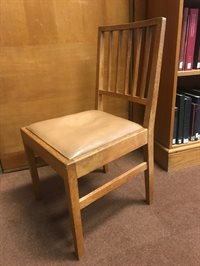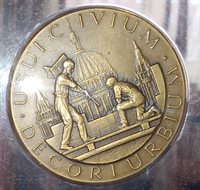The reading rooms
 The Barber Institute and its interiors have grade 1 listed status. The tables and chairs were designed by Gordon Russell, a very well-respected company that was based in Worcestershire and founded by Gordon Russell (1892-1980) in 1923 after he returned from active service in France. Russell was one of the most successful British furniture designers of the twentieth century and the company bearing his name became synonymous with great quality.
The Barber Institute and its interiors have grade 1 listed status. The tables and chairs were designed by Gordon Russell, a very well-respected company that was based in Worcestershire and founded by Gordon Russell (1892-1980) in 1923 after he returned from active service in France. Russell was one of the most successful British furniture designers of the twentieth century and the company bearing his name became synonymous with great quality.
Gordon Russell also designed the furniture for the original Music Library (now the Photograph Room) and the lecture theatre. For more information on Gordon Russell see the Gordon Russell Design Museum.
The clocks on the walls in both the Main and Small reading rooms were manufactured by Dent and Co., the makers of Big Ben.
Bust of Thomas Bodkin by Charles Wheeler
 The sculpture above the metal door in the Main Reading Room is a bust of Thomas Bodkin, the first director of the Institute. It was made by Charles Wheeler, who was a sculptor and also a friend of Bodkin’s. It had been exhibited at the RA in 1958 and was donated to the Institute after Bodkin’s death in 1961. A letter from Bodkin’s widow, Helen, thanked the artist and explained that the Institute had broken its own rules to accept the work. This refers to the terms of the Trust Deed, which stipulated that only ‘works of art or beauty of exceptional or outstanding merit’ executed before the end of the nineteenth century should be acquired. The terms of the deed were changed in 1967 to enable the acquisition of more recent works of art, providing they were over 30 years old.
The sculpture above the metal door in the Main Reading Room is a bust of Thomas Bodkin, the first director of the Institute. It was made by Charles Wheeler, who was a sculptor and also a friend of Bodkin’s. It had been exhibited at the RA in 1958 and was donated to the Institute after Bodkin’s death in 1961. A letter from Bodkin’s widow, Helen, thanked the artist and explained that the Institute had broken its own rules to accept the work. This refers to the terms of the Trust Deed, which stipulated that only ‘works of art or beauty of exceptional or outstanding merit’ executed before the end of the nineteenth century should be acquired. The terms of the deed were changed in 1967 to enable the acquisition of more recent works of art, providing they were over 30 years old.
RIBA Medal
 Embedded in the glass of the interior door to the Main Reading Room is the RIBA (Royal Institute of British Architects) bronze medal awarded to Robert Atkinson for the design of the Institute by the Birmingham and Five Counties Architectural Association in 1946. From its opening, Atkinson received much praise for both the building’s aesthetic and functional merits and leading British architectural historian Sir John Summerson stated that it represented ‘better than almost any other building (except, perhaps the RIBA in Portland Place) the spirit of English architecture in the 1930s’.
Embedded in the glass of the interior door to the Main Reading Room is the RIBA (Royal Institute of British Architects) bronze medal awarded to Robert Atkinson for the design of the Institute by the Birmingham and Five Counties Architectural Association in 1946. From its opening, Atkinson received much praise for both the building’s aesthetic and functional merits and leading British architectural historian Sir John Summerson stated that it represented ‘better than almost any other building (except, perhaps the RIBA in Portland Place) the spirit of English architecture in the 1930s’.